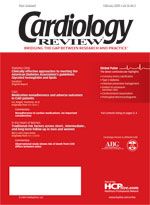Publication
Article
Continuing Medical Education Exam
“High-resolution spiral computed tomography coronary angiography”
Target: CAD/Angina
Learning objectives
Discuss the results of a study using 64-slice spiral computed tomography as an alternative to invasive coronary angiography, considering the advantages and limitations of the technique.
Questions
1. A significant stenosis was defined in the de Feyter study as a decrease in lumen diameter of _______. a ≤50%
b ≥50%
c > 70%
d < 40%
2. In this study, sensitivity, specificity, and positive and negative predictive values for all patients were ____________. a < 65%
b 65%
c 70%
d > 90%
3. Multislice spiral computed tomography (MSCT) coronary angiography cannot be used in patients _____________________________________. a with heart rates over 70 bpm
b with diabetes
c who are 65 years of age or older
d with irregular heart rhythm
4. A _______________ was administered to 73% of patients prior to scanning a beta blocker
b calcium channel blocker
c potassium channel blocker
d angiotensin-converting enzyme (ACE) inhibitor
5. One negative feature of MSCT coronary angiography is the significantly higher radiation dose compared with diagnostic invasive coronary angiography. Through use of the prospective x-ray tube modulation mode, however, this exposure can be reduced by about _______. a 25%
b 30%
c 40%
d 50%
Target: Heart Failure
“Ultrafiltration for heart failure”
Learning objectives
Review the results of a small study looking at the use of minimally invasive ultrafiltration to remove excess fluid in patients with acute decompensated heart failure compared with usual care.
Questions
1. In the Bart et al study, heart failure patients assigned to receive usual care were treated during the initial 24 hours with all but which of the following: a ACE inhibitors
b beta blockers
c diuretics
d digoxin
2. Total fluid removal was _________ in the ultrafiltration group versus the usual care group at 24 hours. a nearly 2 times greater
b nearly 3 times greater
c nearly 4 times greater
d statistically insignificant
3. In 1 study using minimally invasive ultrafilitration, 21 patients with with heart failure and volume overload who received an 8-hour course of ultrafiltration with System 200 had a mean of ______ of fluid removed. a 2838 mL
b 2611 mL
c 5375 mL
d 4650 mL
4. Diuretics have been associated with poor outcomes in patients with congestive heart failure. Possible explanations for such a causal relationship include all but which one of the following? a induction of significant electrolyte abnormalities
b activation of the sympathetic nervous system
c significant increases in blood pressure
d adverse cardiac remodeling
5. In the case study presented, a 61-year-old man was admitted to the hospital for decompensated heart failure, diuretic resistance and progressive azotemia. He underwent 2 ultrafiltration sessions over the first 2 hospital days resulting in all but which of the following?a a 9-pound weight loss
b resolution of edema and shortness of breath
c stabilized potassium level
d blood and urea nitrogen and creatinine levels of 36 and 1.9 mg/dL, respectively






